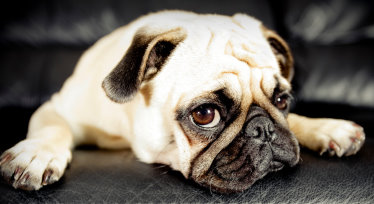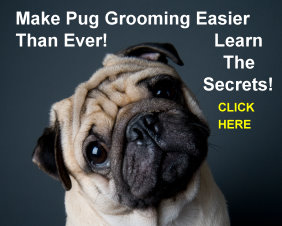|
Pug Breed Standards have been defined by the American Kennel Club
The Pug Breed is one of more than 180 breeds recognized by the American Kennel Club. This organization has an incredible history and is the foremost authority in this country in standardizing everything related to dogs. They are extremely precise in their standards and the information found on this page is taken from their website www.akc.org. Most authorities generally agree that the Pug breed originated in Asia and most probably in China. The breed dates back to at least 400 B.C. He has some similarities to the Pekinese and was a favorite with the Buddhist monks in Tibet. The breed next appeared in Japan and eventually made its way to Europe where it was a favorite in the royal courts. The phrase “multum in parvo” has been used to describe the Pug breed and it translates roughly to a lot of dog in a small space. The Pug is an endearing breed of dog who seems to like nothing better than to be with his people especially children. The Pug is an even-tempered breed and exhibits playfulness, stability and dignity. Pugs have great charm and a loving, outgoing personality. The general appearance of the Pug is described as square and cobby with well-knit proportions and hardness of muscle. A Pug with legs or body that are too long deviates from the desirable “squareness” of shape. The ideal weight should be between 14 and 18 pounds. A compact, well-proportioned “square” should be what one looks for in this breed. The head is large, massive and round. There is no indentation of the skull. The ideal Pug is not “apple-headed”. The eyes are dark in color and very large and prominent. They are globular in shape and their expression should be soft and solicitous. Their eyes are lustrous and can become “full of fire” when excited. The Pug’s ears are thin, soft and smooth as black velvet. The wrinkles in the forehead should be large and deep. Their muzzle should be short, blunt and square with their bite just slightly undershot. The black area around the mouth is sometimes called the mask. All of the markings on the Pug face should be as black as possible. This includes any moles on the face. The wrinkles should be large and deep. The neck should be just long enough to carry the head proudly and should be thick and strong with just a slight arch. The back is level and the body short and cobby. The Pug is wide at the chest and well-ribbed. The tail is curled tightly over the hip with a double curl being perfection. The legs are straight, strong and of moderate length and the shoulders are moderately laid back. The feet are described as being “neither so long as the foot of the hare, nor so round as that of the cat”. The toes are well split and the nails are black. When viewed from behind the legs are parallel and the hindquarters are in balance with the forequarters. The thighs and buttocks are full and muscular. The coat is fine, smooth and soft rather than hard or woolly. The coat should be glossy and the Pug colors are either fawn or black. In a fawn the contrast should be complete between the color, the trace and the mask. The markings should include a thumb mark or diamond on the forehead with a trace as black as possible on the back. The mask should be black and the more intense and black the better. Viewed from the front, the Pug’s gait should show no weakness and the forelegs should be well forward. The feet should not turn out at all. The rear action should be strong and free with no twisting or turning at the joints. The hind legs should follow the front in a straight line and the gait should be self assure and “jaunty”. Coloring for the Pug Breed is very specific. It should be noted that any color other than black or fawn is a disqualification for showing a Pug. The American Kennel Club constantly updates these Pug Breed characteristics and you can find them for any breed. The summary above was taken from a description that became effective in June of 2008.
There is a growing area of dog breeding that we have some mixed feelings about and that is the concept of hybrid or mixed breed dogs. These dogs have been referred to sometimes as Designer Dogs. As we know, Pugs are extremely adorable, intelligent and friendly dogs who make great companions so it is no surprise that they are popular in this trend of mixing breeds. We know we are more than a little biased but we think Pugs are perfect the way they are. However, hybrid dogs are extremely popular. Of course, it should be no surprise that the Puggle is the most popular of these. This mix of the Pug and Beagle breeds accounts for almost half of the registered hybrid dogs in the United States. 
|